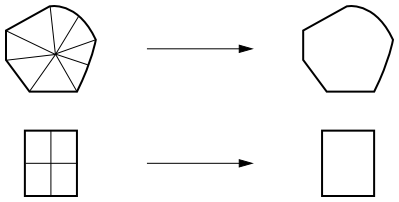Ansys Fluent’s approach to forming the multigrid grid hierarchy for FAS is simply to coalesce groups of cells on the finer grid to form coarse grid cells. Coarse grid cells are created by agglomerating the cells surrounding a node, as shown in Figure 23.12: Node Agglomeration to Form Coarse Grid Cells. Depending on the grid topology, this can result in cells with irregular shapes and variable numbers of faces. The grid levels are, however, simple to construct and are embedded, resulting in simple prolongation and relaxation operators.
It is interesting to note that although the coarse grid cells look very irregular, the discretization cannot "see" the jaggedness in the cell faces. The discretization uses only the area projections of the cell faces and therefore each group of "jagged" cell faces separating two irregularly-shaped cells is equivalent to a single straight line (in 2D) connecting the endpoints of the jagged segment. (In 3D, the area projections form an irregular, but continuous, geometrical shape.) This optimization decreases the memory requirement and the computation time.
FAS requires restriction of both the fine grid solution and its residual (defect)
. The restriction operator
used to transfer the solution
to the next coarser grid level is formed using a full-approximation
scheme [75]. That is, the solution for
a coarse cell is obtained by taking the volume average of the solution
values in the embedded fine grid cells. Residuals for the coarse grid
cell are obtained by summing the residuals in the embedded fine grid
cells.
The prolongation operator used to transfer corrections up to the fine level
is constructed to simply set the fine grid correction to the associated
coarse grid value.
The coarse grid corrections , which are
brought up from the coarse level and applied to the fine level solution,
are computed from the difference between the solution calculated on
the coarse level
and the initial solution
restricted down to the coarse level
. Thus correction
of the fine level solution becomes
(23–146) |
The FAS coarse grid operator is simply
that which results from a re-discretization of the governing equations
on the coarse level mesh. Since the discretized equations presented
in Discretization and Density-Based Solver place no restrictions on the number
of faces that make up a cell, there is no problem in performing this
re-discretization on the coarse grids composed of irregularly shaped
cells.
There is some loss of accuracy when the finite-volume scheme is used on the irregular coarse grid cells, but the accuracy of the multigrid solution is determined solely by the finest grid and is therefore not affected by the coarse grid discretization.
In order to preserve accuracy of the fine grid solution, the
coarse level equations are modified to include source terms [276] which insure that corrections computed on
the coarse grid will be zero if the
residuals on the fine grid
are zero as well. Thus, the
coarse grid equations are formulated as
(23–147) |
Here is the coarse grid residual
computed from the current coarse grid solution
, and
is the coarse grid residual computed from the restricted
fine level solution
. Initially, these two terms
will be the same (because initially we have
) and cancel from the equation, leaving
(23–148) |
So there will be no coarse level correction when the fine grid
residual is zero.



